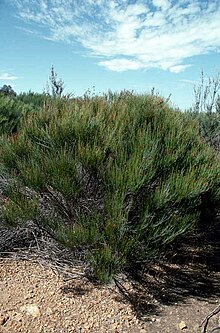Allocasuarina campestris
| Allocasuarina campestris | |
|---|---|

| |
| Near Wongan Hills | |
| Scientific classification | |
| Kingdom: | Plantae |
| Clade: | Tracheophytes |
| Clade: | Angiosperms |
| Clade: | Eudicots |
| Clade: | Rosids |
| Order: | Fagales |
| Family: | Casuarinaceae |
| Genus: | Allocasuarina |
| Species: | A. campestris |
| Binomial name | |
| Allocasuarina campestris | |
| Synonyms[1] | |
List
| |

Allocasuarina campestris is a species of flowering plant in the family Casuarinaceae and is endemic to the south-west of Western Australia. It is a dense, monoecious or dioecious shrub that has more or less erect branchlets, the leaves reduced to scales in whorls of seven to nine, the mature fruiting cones 19–42 mm (0.75–1.65 in) long containing winged seeds (samaras) 4.7–10 mm (0.19–0.39 in) long.
Description
Allocasuarina campestris is a dense, erect, monoecious or dioecious shrub that typically grows to a height of 1–3 m (3 ft 3 in – 9 ft 10 in). Its branchlets are more or less erect, up to 200 mm (7.9 in) long, the leaves reduced to erect, scale-like teeth 0.3–1.2 mm (0.012–0.047 in) long, arranged in whorls of seven to nine, around the branchlets. The sections of branchlet between the leaf whorls (the "articles") are 6–13 mm (0.24–0.51 in) long and 0.6–1.2 mm (0.024–0.047 in) wide. Male flowers are arranged in spikes 4–28 mm (0.16–1.10 in) long, in whorls of 8.5 to 11 per centimetre (per 0.39 in.), the anthers 0.9–1 mm (0.035–0.039 in) long. Female cones are red to brown, covered with short, fine, white hairs when young, and are sessile or on a peduncle up to 5 mm (0.20 in) long. Mature cones are 19–42 mm (0.75–1.65 in) long and 10–17 mm (0.39–0.67 in) in diameter, the samaras black and 4.7–10 mm (0.19–0.39 in) long.[2]
Taxonomy
This species was first formally described in 1904 by Ludwig Diels who gave it the name Casuarina campestris in Botanische Jahrbücher für Systematik, Pflanzengeschichte und Pflanzengeographie, from specimens collected near Watheroo.[3][4] It was reclassified in 1982 as Allocasuarina campestris by Lawrie Johnson in the Journal of the Adelaide Botanic Gardens.[5] The specific epithet (campestris) means "pertaining to plains or flat areas, as opposed to hills and mountains".[6]
Distribution and habitat
Allocasuarina campestris is widespread in the south-west of Western Australia, from north of the Murchison River almost to the south coast near Ravensthorpe and to east of Esperance, where it grows on sandplains.[2][7]
References
- ^ a b "Allocasuarina campestris". Australian Plant Census. Retrieved 16 May 2023.
- ^ a b "Allocasuarina campestris". Australian Biological Resources Study, Department of Agriculture, Water and the Environment: Canberra. Retrieved 15 May 2023.
- ^ "Casuarina campestris". APNI. Retrieved 16 May 2023.
- ^ Diels, Ludwig (1904). "Fragmenta Phytographiae Australiae occidentalis. Beitrage zur Kenntnis der Pflanzen Westaustraliens, ihrer Verbreitung und ihrer Lebensverhaltnisse". Botanische Jahrbücher für Systematik, Pflanzengeschichte und Pflanzengeographie. 35 (1): 126. Retrieved 16 May 2023.
- ^ "Allocasuarina campestris". APNI. Retrieved 16 May 2023.
- ^ William T. Stearn (1992). Botanical Latin. History, grammar, syntax, terminology and vocabulary (4th ed.). Portland, Oregon: Timber Press. p. 381.
- ^ "Allocasuarina campestris (Diels) L.A.S.Johnson". FloraBase. Western Australian Government Department of Biodiversity, Conservation and Attractions.
